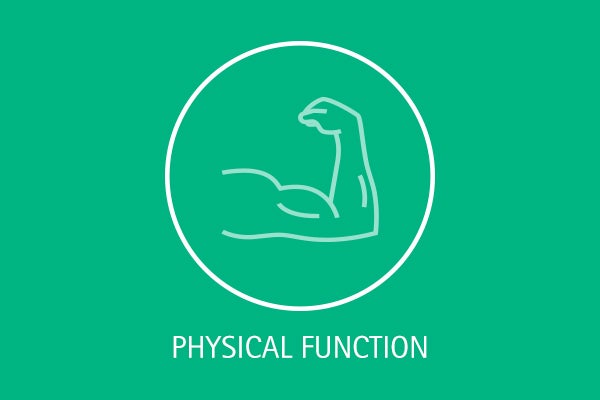Measuring muscle strength
Not only muscle mass but also muscle strength plays an important role in defining sarcopenia. A wide range of tests is available, including the chair stand test (chair rise test), the SARC-F questionnaire and handgrip strength.1 Find more information about the latter below.
Handgrip strength (HGS)

Handgrip strength is a simple, non-invasive and easy method for assessing muscle strength. HGS is independently associated with survival and important biological, functional and quality-of-life characteristics in advanced cancer patients.2
Why is Handgrip strength an important measure?
Patients with lower HGS showed2
- lower BMI
- shorter survival
- lower hemoglobin and albumin
- greater occurrence of sarcopenia
- lower quality of life (QoL)
- higher levels of fatigue
- poorer performance status
- lower fat mass
- lower lean body mass
How to measure Handgrip strength?
Handgrip strength is quantified by measuring the amount of power that the hand presses around a dynamometer, (see Fig. 1).3,4 The force has most commonly been measured in kilograms and pounds. For more consistent measurements of HGS a standardized method is needed.4
The European Working Group on Sarcopenia in Older People (EWGSOP2) recommends HGS as a good, simple measure of muscle strength.1
HGS is a useful method to predict muscle strength in the prediction of sarcopenia.
Performance status (PS)
Performance status (PS) represents a global assessment of the patient’s level of function.5 Impaired PS in patients with cancer is independently associated with an unfavorable prognosis.5,6
Why measure Performance status?
Patients with a poor PS are associated with increased risk for chemotherapy toxicity and poor outcomes compared to patients with better performance status.7 The nutritional status of cancer patients is also strongly correlated with PS.8 Patient PS can and usually does change over time.9
How to measure Performance status?
PS in oncology can be easily measured by the Eastern Cooperative Oncology Group (ECOG) or Karnofsky Performance Status (KPS) scale.5
Performance status is important to determine the patient’s level of function and outcome.
Performance status measurements
Eastern Cooperative Oncology Group (ECOG) scale
The ECOG scale is also called the WHO Performance Status.9 It was developed in 1960 and is a simple measure composed of six categories that range from normal activity, with a score of 0, to death, with a score of 5.5 The ECOG scale is often preferred for its simplicity and interobserver reproducibility.7
Karnofsky Performance Status (KPS) scale
The KPS scale was developed in 1948 to evaluate the ability of patients with cancer to tolerate chemotherapy. It is composed of 11 categories, which range from normal activity (100) to death (0).5
The KPS is increasingly used as a prognostic factor in patient assessment.10 Lower scores (less than 40) are associated with rapid disease progression and poor survival.11 For many clinical trials, the treatment recommendations are restricted to more fit patients, such as those with a KPS scale score higher than 70.9 Some societies recommend the initiation of home parenteral nutrition at a KPS scale score > 50.12,13
Nutritional assessments
References
1 Cruz-Jentoft AJ, Bahat G, Bauer J, Boirie Y, Bruyere O, Cederholm T, et al. Sarcopenia: revised European consensus on definition and diagnosis. Age ageing. 2019;48(1):16-31.
2 Kilgour RD, Vigano A, Trutschnigg B, Lucar E, Borod M, Morais JA. Handgrip strength predicts survival and is associated with markers of clinical and functional outcomes in advanced cancer patients. Support Care Cancer. 2013;21(12):3261-70.
3 Cederholm T, Barazzoni R, Austin P, Ballmer P, Biolo G, Bischoff SC, et al. ESPEN guidelines on definitions and terminology of clinical nutrition. Clin Nutr. 2017;36(1):49-64.
4 Roberts HC, Denison HJ, Martin HJ, Patel HP, Syddall H, Cooper C, et al. A review of the measurement of grip strength in clinical and epidemiological studies: towards a standardised approach. Age ageing. 2011;40(4):423-9.
5 Jang RW, Caraiscos VB, Swami N, Banerjee S, Mak E, Kaya E, et al. Simple prognostic model for patients with advanced cancer based on performance status. J Oncol Pract. 2014;10(5):e335-41.
6 Arends J, Bachmann P, Baracos V, Barthelemy N, Bertz H, Bozzetti F, et al. ESPEN guidelines on nutrition in cancer patients. Clin Nutr. 2017;36(1):11-48.
7 Kelly CM, Shahrokni A. Moving beyond Karnofsky and ECOG Performance Status Assessments with New Technologies. J Oncol. 2016;2016:6186543.
8 Hébuterne X, Lemarie E, Michallet M, de Montreuil CB, Schneider SM, Goldwasser F. Prevalence of malnutrition and current use of nutrition support in patients with cancer. JPEN J Parenter Enteral Nutr. 2014;38(2):196-204.
9 West HJ, Jin JO. JAMA Oncology Patient Page. Performance Status in Patients With Cancer. JAMA oncology. 2015;1(7):998.
10 Peus D, Newcomb N, Hofer S. Appraisal of the Karnofsky Performance Status and proposal of a simple algorithmic system for its evaluation. BMC Med Inform Decis Mak. 2013;13:72.
11 McCallum PD. Nutrition Screening and Assessment in Oncology. In: Oncology Nutrition Dieteic Practice Group, Elliott LE, Molseed LL, McCallum PD, Grant B, editors. The Clinical Guide to Oncology Nutrition: American Dietetic Association; 2006:44-53.
12 August DA, Huhmann MB. A.S.P.E.N. clinical guidelines: nutrition support therapy during adult anticancer treatment and in hematopoietic cell transplantation. JPEN J Parenter Enteral Nutr. 2009;33(5):472-500.
13 Staun M, Pironi L, Bozzetti F, Baxter J, Forbes A, Joly F, et al. ESPEN Guidelines on Parenteral Nutrition: home parenteral nutrition (HPN) in adult patients. Clin Nutr. 2009;28(4):467-79.



